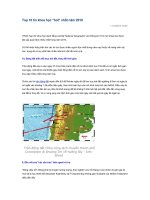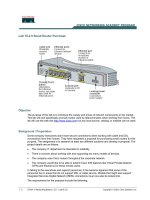Tài liệu Top 10 Reasons Why TCP Is Reliable ppt
Bạn đang xem bản rút gọn của tài liệu. Xem và tải ngay bản đầy đủ của tài liệu tại đây (176.38 KB, 12 trang )
Top 10 Reasons Why
TCP Is Reliable
1-800-COURSES
www.globalknowledge.com
Expert Reference Series of White Papers
Introduction
The protocol used on the Internet for reliable communication is the Transmission Control Protocol (TCP). In this
paper, you will learn some of the essentials of TCP by looking at 10 of the top features that make it reliable.
In-depth knowledge of protocols can help you in many ways. It enables more efficient troubleshooting. It
allows you to understand how firewalls and routers limit the flow of dangerous information in and out of your
networks
. Our discussion in this white paper is a good introduction,
but it does not represent a full,
detailed
analysis of TCP.
1. Mature Protocol
Whether or not you agree with the idea,
the Transmission Control Protocol (TCP) is reliable because it is a
mature protocol. Problems that exist in newer protocols have all been ironed out in the long-standing protocol
TCP. TCP is based on Request for Comment (RFC) 793. An RFC is an Internet document that describes process-
es and procedures recognized by the Internet Engineering Task Force. RFC 793, released as a standard in 1981,
is the standard that describes how TCP operates. TCP features the following 9 capabilities that lead to its true
reliability.
Protocol captures are being included in the white paper to illustrate the reliability issues discussed. These cap-
tures were created with Omnipeek Personal, which is a product from WildPackets, Inc.
2. Orderly Session Startup Process
TCP begins a session by going through a three-step startup process. In step 1, the client sends a special
request called a Synchronize to the service with which it is attempting to connect. In step 2, the service sends
an Acknowledgement back to the client informing the client that the attempt to connect has been received.
T
he service also sends a Synchronize request with the
Acknowledgement.
T
he Synchronize sent by the service
tells that client that the service is also ready to connect to send information to the client,
if necessary
.
Finally,
the third step is an Acknowledgement message sent to the service from the client to let the service know that
the client is ready to accept information from the service, if it is sent. Once all three steps have been complet-
ed, the session between the client and the service is established.
Step 1.
In the captured packet below, which shows the start of a FTP session between a client and a service, you will
see that the
TCP Flags area contains a 1 in the SYN flag indicating the first step of the three-step
“handshak
e
.
”
Ted Rohling, Global Knowledge Instructor, CISSP
Top 10 Reasons Why TCP Is Reliable
Copyright ©2007 Global Knowledge T
raining LLC. All rights reserved.
Page 2
T
CP - Transport Control Protocol
S
ource Port:
4
6139
Destination Port: 21 ftp
Sequence Number: 3213898066
Ack Number: 0
T
CP Offset:
1
0 (40 bytes)
Reserved: %0000
TCP Flags: %00000010 ......S.
0... .... (No Congestion Window Reduction)
.0.. .... (No ECN-Echo)
..0. .... (No Urgent pointer)
...0 .... (No Ack)
.... 0... (No Push)
.... .0.. (No Reset)
.... ..1. SYN
.... ...0 (No FIN)
Window: 5840
TCP Checksum: 0x3ABA
Urgent Pointer: 0
Step 2.
In the captured pack
et below, you will see that the TCP Flags area contains a 1 in the SYN flag and a 1 in the
Ack flag indicating the second step of the three-step handshake.
TCP - Transport Control Protocol
Source Port: 21 ftp
Destination Port: 46139
Sequence Number: 2062083365
Ack Number: 3213898067
TCP Offset: 11 (44 bytes)
Reserved: %0000
TCP Flags: %00010010 ...A..S.
0... .... (No Congestion Window Reduction)
.0.. .... (No ECN-Echo)
..0. .... (No Urgent pointer)
...1 .... Ack
.... 0... (No Push)
.... .0.. (No Reset)
.... ..1. SYN
.... ...0 (No FIN)
Window: 65535
TCP Checksum: 0xAD48
Urgent Pointer: 0
Step 3.
In the captured packet below, you will see that the TCP Flags area contains a 1 in the Ack flag indicating the
third step of the three-step handshake.
Copyright ©2007 Global Knowledge T
raining LLC. All rights reserved.
Page 3
T
CP - Transport Control Protocol
Source Port: 46139
Destination Port: 21 ftp
Sequence Number: 3213898067
A
ck Number:
2
062083366
TCP Offset: 8 (32 bytes)
Reserved: %0000
TCP Flags: %00010000 ...A....
0... .... (No Congestion Window Reduction)
.0.. .... (No ECN-Echo)
..0. .... (No Urgent pointer)
...1 .... Ack
.... 0... (No Push)
.... .0.. (No Reset)
.... ..0. (No SYN)
.... ...0 (No FIN)
Window: 1460
TCP Checksum: 0x1A7D
Urgent Pointer: 0
The session between the client and the service is now established. Actually, it is really two sessions, one from
the client to the service and one from the service to the client. This allows full duplex data transmission to
occur.
3. Full Duplex Data Transmission.
The fact that
TCP allows both the client and the service to send information at the same time was a major
departure from protocol in use at the time TCP was created. Full duplex transmission actually speeds up the
process of communicating. Rather than waiting for a client or service to acknowledge transmission, senders
are at will to acknowledge received data at the same time they transmit information.
Applications submit data to
TCP for transmission. Often the data is submitted as large blocks of information as
in files
, HTML pages or images. As TCP transmits data, it creates segments from the larger blocks. Segments
are ideally sized to match the physical network being used to transport the data. More about segments later in
the paper.
4. Accounting for Information Transfer.
In the examples below, a session has been established between an email client and an email service. To
account for information being transmitted between client and service
,
TCP uses sequence numbers
.
Two differ-
ent sequence numbers are established for transmission from the client to the service and from the service to
the client.
In the next segment, the email client is sending information to the email service. The sequence number shows
the v
alue representing the first byte of the email message in the segment.
TCP - Transport Control Protocol
Source Port: 1254 de-noc
Destination Port: 25 smtp
Sequence Number: 2173105768
Copyright ©2007 Global Knowledge T
raining LLC. All rights reserved.
Page 4
A
ck Number:
2
247743657
TCP Offset: 5 (20 bytes)
Reserved: %0000
TCP Flags: %00010000 ...A....
0
... .... (No Congestion Window Reduction)
.0.. .... (No ECN-Echo)
..0. .... (No Urgent pointer)
...1 .... Ack
.... 0... (No Push)
.... .0.. (No Reset)
.... ..0. (No SYN)
.... ...0 (No FIN)
Window: 65273
TCP Checksum: 0x895B
Urgent Pointer: 0
A second packet or segment was immediately sent to the service by the client. The sequence number shows
the value representing the first byte of the email message in the second packet. This sequence number can be
used to show how much information was in the last segment.
TCP - Transport Control Protocol
Source Port: 1254 de-noc
Destination Port: 25 smtp
Sequence Number: 2173107228
Ack Number: 2247743657
TCP Offset: 5 (20 bytes)
Reserved: %0000
TCP Flags: %00011000 ...AP...
0... .... (No Congestion Window Reduction)
.0.. .... (No ECN-Echo)
..0. .... (No Urgent pointer)
...1 .... Ack
.... 1... Push
.... .0.. (No Reset)
.... ..0. (No SYN)
.... ...0 (No FIN)
Window: 65273
TCP Checksum: 0x877D
Urgent Pointer: 0
No TCP Options
Sequence number frame 2 2173107228
Sequence number frame 1 2173105768
Difference
1460
By subtracting the sequence number of the first segment from the sequence number of the second segment,
we can calculate the number of bytes found in the first segment. In this case, the TCP payload or data being
carried by TCP is 1460 bytes.
Copyright ©2007 Global Knowledge T
raining LLC. All rights reserved.
Page 5









